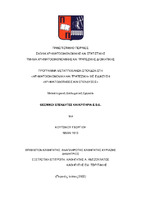Θεσμικοί επενδυτές και κριτήρια E.S.G.

View/
Keywords
Κριτήρια E.S.G.Abstract
Sustainability and corporate governance practices are constantly evolving in the European Union. Many measures have been implemented in the EU aiming at encouraging the integration of ESG factors into the investment process of organizations, while ensuring investors’ protection and adequate shareholders’ rights. The willingness of policy makers to initiate a shift towards more sustainable processes is clear and the current crisis is likely to accelerate this transition. Investors are also becoming more active in the engagement process to actively influence companies' ESG decisions (CFA Institute, 2021).
In 2020, demand for sustainable products from European investors, including investment funds pursuing environmental, social and governance (ESG) strategies, continued to grow significantly. Net flows into ESG equities, bonds and mixed funds in the European Union accelerated further throughout 2020, with a value of €67 billion (ESMA, 2022). Both ESG asset investing and ESG debt issuance have been growing rapidly in recent years and are driving investment strategies. If there is global growth of 15% by 2025 (half the rate of change of the last five years), ESG assets could exceed $50 trillion. The ESG fund market is expected to reach $11 trillion by 2025 (Bloomberg, 2021).
The ESG evaluation over time strengthens and becomes more and more decisive for making investment decisions. Sustainability and ESG education are constantly being enriched by new trends, regulations and tools. The growing awareness of ESG issues also increases the need for proper and continuous training of management and senior executives of companies. Recently, the emphasis on climate change and natural resource management has become more intense. In general, evaluations by external providers improve the reliability, accuracy and transparency of corporate disclosures and are expected to increase (CSE, 2021).
The Center for Sustainability and Excellence's annual report states that an analysis of 659 North American corporate sustainability reports in 2018-2019 found that companies with high ESG scores show higher financial performance. Industries with a high degree of disclosure of ESG issues are the financial services, energy, food and healthcare industries. It is a positive fact that the involvement of smaller companies with ESG issues is increasing more and more. The main guidelines for preparing sustainability reports are the GRI standards (CSE, 2020).
This paper aims to investigate the importance investors give to ESG issues and corporate returns, focusing on mutual funds. The development of the work is divided into the theoretical and the practical part. In theory, key concepts and issues related to institutional investors, ESG issues and relevant empirical research findings are analyzed and presented. The practical part is developed based on two approaches. Initially, the views and experience of a market executive are captured on the developments and perspectives of ESG issues. Then, through quantitative research, it is investigated whether ESG funds present deviations in performance compared to traditional funds as well as the degree of influence of the reference level of ESG disclosures (more specifically, the ESG rating by Refinitiv).
The paper is developed in seven chapters. The first (present) chapter contains introductory information, the purpose and the structure of the work. The second chapter presents basic concepts for investors and especially for institutional ones such as their types and objectives as well as the current developments in the market of institutional investors worldwide. The third chapter analyzes the meaning of the term ESG (Environment, Social and Governance), the guidelines for companies to disclose ESG issues and their measurement. The fourth chapter presents the literature review, based on recent research on ESG issues and their relationship with stock and mutual fund returns. The fifth chapter presents the interview on the subject held with the Director of the Investment Portfolios Department of Alpha Bank. The sixth chapter includes the quantitative research and specifically the methodology and its results. The last chapter presents the conclusions of the paper.


